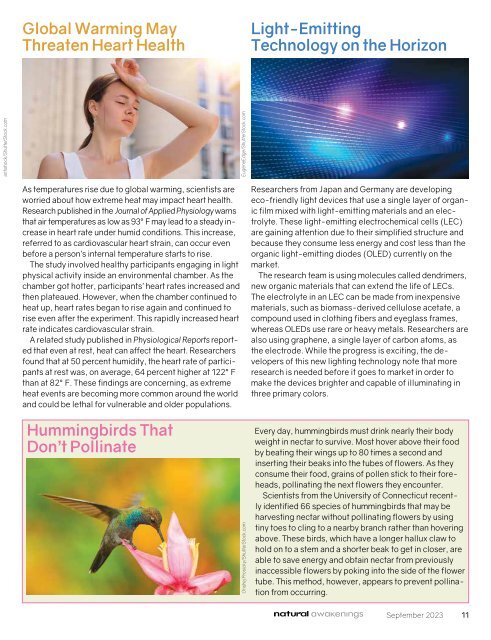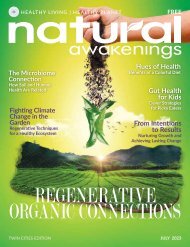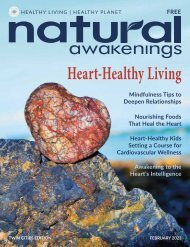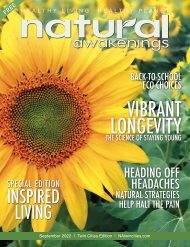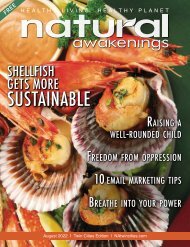Natural Awakenings Twin Cities September 2023 Issue
Read the September 2023 edition of Natural Awakenings Twin Cities magazine. This is our annual Inspired Living Issue which features articles on traveling with purpose, medical tourism, understanding light pollution, helping kids cope with anxiety, embracing the winding road, and so much more! Be sure to check out our local content, including News Brief announcements, Community Resource Guide with providers throughout the metro who can meet your individual wellness needs, and all the happenings in the Calendar of Events. There is additional online-only content that can be found at NATwinCities.com.
Read the September 2023 edition of Natural Awakenings Twin Cities magazine. This is our annual Inspired Living Issue which features articles on traveling with purpose, medical tourism, understanding light pollution, helping kids cope with anxiety, embracing the winding road, and so much more!
Be sure to check out our local content, including News Brief announcements, Community Resource Guide with providers throughout the metro who can meet your individual wellness needs, and all the happenings in the Calendar of Events. There is additional online-only content that can be found at NATwinCities.com.
You also want an ePaper? Increase the reach of your titles
YUMPU automatically turns print PDFs into web optimized ePapers that Google loves.
Global Warming May<br />
Threaten Heart Health<br />
Light-Emitting<br />
Technology on the Horizon<br />
antishock/ShutterStock.com<br />
EugeneEdge/ShutterStock.com<br />
As temperatures rise due to global warming, scientists are<br />
worried about how extreme heat may impact heart health.<br />
Research published in the Journal of Applied Physiology warns<br />
that air temperatures as low as 93° F may lead to a steady increase<br />
in heart rate under humid conditions. This increase,<br />
referred to as cardiovascular heart strain, can occur even<br />
before a person’s internal temperature starts to rise.<br />
The study involved healthy participants engaging in light<br />
physical activity inside an environmental chamber. As the<br />
chamber got hotter, participants’ heart rates increased and<br />
then plateaued. However, when the chamber continued to<br />
heat up, heart rates began to rise again and continued to<br />
rise even after the experiment. This rapidly increased heart<br />
rate indicates cardiovascular strain.<br />
A related study published in Physiological Reports reported<br />
that even at rest, heat can affect the heart. Researchers<br />
found that at 50 percent humidity, the heart rate of participants<br />
at rest was, on average, 64 percent higher at 122° F<br />
than at 82° F. These findings are concerning, as extreme<br />
heat events are becoming more common around the world<br />
and could be lethal for vulnerable and older populations.<br />
Researchers from Japan and Germany are developing<br />
eco-friendly light devices that use a single layer of organic<br />
film mixed with light-emitting materials and an electrolyte.<br />
These light-emitting electrochemical cells (LEC)<br />
are gaining attention due to their simplified structure and<br />
because they consume less energy and cost less than the<br />
organic light-emitting diodes (OLED) currently on the<br />
market.<br />
The research team is using molecules called dendrimers,<br />
new organic materials that can extend the life of LECs.<br />
The electrolyte in an LEC can be made from inexpensive<br />
materials, such as biomass-derived cellulose acetate, a<br />
compound used in clothing fibers and eyeglass frames,<br />
whereas OLEDs use rare or heavy metals. Researchers are<br />
also using graphene, a single layer of carbon atoms, as<br />
the electrode. While the progress is exciting, the developers<br />
of this new lighting technology note that more<br />
research is needed before it goes to market in order to<br />
make the devices brighter and capable of illuminating in<br />
three primary colors.<br />
Hummingbirds That<br />
Don’t Pollinate<br />
Ondrej Prosicky/ShutterStock.com<br />
Every day, hummingbirds must drink nearly their body<br />
weight in nectar to survive. Most hover above their food<br />
by beating their wings up to 80 times a second and<br />
inserting their beaks into the tubes of flowers. As they<br />
consume their food, grains of pollen stick to their foreheads,<br />
pollinating the next flowers they encounter.<br />
Scientists from the University of Connecticut recently<br />
identified 66 species of hummingbirds that may be<br />
harvesting nectar without pollinating flowers by using<br />
tiny toes to cling to a nearby branch rather than hovering<br />
above. These birds, which have a longer hallux claw to<br />
hold on to a stem and a shorter beak to get in closer, are<br />
able to save energy and obtain nectar from previously<br />
inaccessible flowers by poking into the side of the flower<br />
tube. This method, however, appears to prevent pollination<br />
from occurring.<br />
<strong>September</strong> <strong>2023</strong><br />
11


